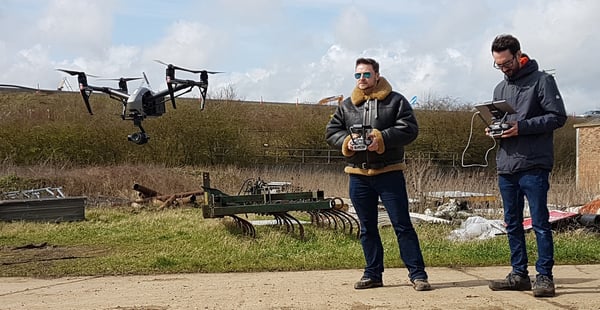In this article, we take you through some DJI aircraft to see which drone may be appropriate for you, should you wish to focus on its filming capability. I do have to stipulate that we are not endorsed by DJI and all the information provided is purely from our experience and understanding of each of the drones.
I'll also not be including the DJI Matrice 600 as I'm sure you can understand if you are in the market for this aircraft you wouldn't have even considered the DJI Spark!
So, speaking of the DJI Spark, let's jump right in with DJI's smallest aircraft.
Read time ~ 5 minutes
DJI Spark ~ £450+
The DJI Spark is the smallest drone in their consumer range. The aircraft fits into the palm of your hand and looks somewhat like a toy, however, don't be fooled by its appearance. The Spark is quite a robust little UAV with some respectable features.
The DJI Spark has the same sensor size as the Mavic Pro and Mavic Air and captures stills at the same resolution of 12MP.
It has a fixed focal length of 25mm equivalent and shoots up to 1080p only. So if you want to shoot in 4K or UHD, then this is not the drone for you! If however, FHD is more than plenty for your productions then maybe the DJI Spark is a highly cost-effective tool to add to your portable arsenal.
My primary concern with using the DJI Spark on commercial film productions would be that because of it's size and fun factor appearance it might not look as professional as some of the larger aircraft, however as they always size, size isn't everything!
The other thing to bear in mind is that the maximum video bit-rate is a meagre 24 Mbps. On the other hand, when the Canon C100 was released, it could only shoot 1080p AVCHD at 24Mbps, and we used to use that on many productions!
Here's a brief breakdown below of the specs.
- 1/2.3" Sensor
- f/2.6 wide-angle lens (with a 25 mm equivalent focal length)
- 1080p Video (h.264 MP4)
- Stills at 12 MP
- up to 30fps
- Max Video Bit-rate - 24Mbps
- Storage
Check out deputy chief drone pilot Tom Pattison's review of the DJI Spark here:
https://blog.flyicarus.co.uk/can-a-dji-spark-be-used-commercially-first-impressions
DJI Mavic Pro ~ £1000+
When DJI released the Mavic Pro, it took the wider drone community by storm, much like the Phantom 2 did! When it folds up, its portability factor was almost the perfect solution for many enthusiasts.
For the professional environment, it sits in an awkward position. If you wanted a drone that takes excellent high-resolution stills as well as the video, then the Mavic Pro probably isn't for you. At only 12MP the resolution is quite small compared the Phantom 4 range.
Where the DJI Mavic Pro starts to stand out is its video capability. It can shoot up to 4K (albeit only on a 1/2.3" sensor) and can capture slow-motion video at 96fps when shooting 1080p! It also has a maximum video bit-rate of 60 Mbps, over double the quality of the DJI Spark.
Where I feel the Mavic Pro sits is low budget corporate video shoots where you need to keeps costs low but production value high. It can easily be operated with one person (but always try to work as a pair for safety!), and you'll be able to capture in stunning 4K.
- 1/2.3" Sensor
- f/2.2 wide-angle lens (with a 26mm equivalent focal length)
- 4K Video
- Stills at 12MP
- up to 120fps (720p only)
- Max Video Bitrate - 60 Mbps
- Storage - Micro SD™
Check out this blog by DJI -
10 Common Mistakes Mavic Pro Pilots Make |
DJI Mavic Air ~ £800 +
The DJI Mavic air is one of DJI's latest innovations, fitting in somewhere between the DJI Spark and the DJI Mavic Pro. From a side, by side specs comparison the Mavic Air and the Mavic Pro are very similar. What I did notice with the Air is the max video bit-rate is 100Mbps vs the Mavic Pro's 60Mbps, so in theory, it should give a better image quality. Now, this isn't always the case, but it does seem like a big jump!
It's strange that DJI would choose to up the quality of the recording capabilities on an aircraft that is less price than it's Pro equivalent.
What you will find very different is the video transmission feed. The Air is built on similar technology to the Spark and only live transmits at 720p whereas the Mavic Pro can live transmit at 1080p. So if you want to make sure you get a clearer sharper image when shooting live then go for the Pro.
Where I think the DJI Mavic Air fits in is with people who do a lot of travelling. I believe that if you want to use the Mavic Air for commercial use, I would recommend you go for the Pro. The fact you get a better image during live transmission to your mobile device means you can be sure that you've got everything in focus and know exactly what you are getting, especially if you've only got one chance to get that shot!
- 1/2.3" Sensor
- f/2.8 wide-angle lens (with a 24mm equivalent focal length)
- 4K Video (h.264 MOV/MP4)
- Stills at 12MP
- up to 120fps (720p only)
- Max Video Bitrate - 100 Mbps
- Storage - Micro SD™
DJI Phantom 4 Pro ~ £1500+
The Phantom is really what exploded the drone market, and even with the release of the Mavic, it holds it's ground due to it's more Pro features. It is the last drone that sits in the consumer range.
The two significant advantages of the Phantom 4 Pro over the Mavic range is the larger 1" sensor and the fact it can shoot stills at 20MP vs the Mavic's 12MP.
The next major item I have to point out is the fact that you can film in h.265 or High-Efficiency Video Coding (HEVC). For those that aren't aware of this codec, you should check out this BBC R&D blog about how it saved 50% on the bit-rate recording. Basically, you can record better quality recordings (up to 8K) with less storage space because of the improved compression algorithms. It's gradually becoming the standard codec that will eventually replace H.264.
Check out these compression guidelines and explanations from Vimeo.
https://vimeo.com/help/compression
If you are looking at shooting high-quality slow-motion drone shots, the DJI Phantom 4 Pro is capable of shooting 1080p at a whopping 120fps and 4K at 60fps. This opens up scope for some genuinely spectacular cinematic shots that you wouldn't be able to achieve with a Mavic.
The DJI Phantom 4 Pro fits perfectly into all types of corporate productions. I would say it's not suited for high-end productions since you can't shoot ProRes or RAW, but it certainly holds its ground for most productions.
You also don't have the option to have dual operator controls so you can have an independent camera and gimbal operator. So if you are looking at getting the most dynamic shots, you may need to look towards something like the Inspire range
- 1" Sensor
- f/2.8 wide-angle lens (with a 24mm equivalent focal length)
- 4K Video (h.264/h.265 MOV/MP4)
- Stills at 20MP
- up to 120fps at 1080p
- up to 60fps at 4K
- Max Video Bitrate - 100 Mbps
- Storage - Micro SD™
DJI Inspire 2 with X5S ~ £4000+
The Inspire 2 with the X5S camera is the drone that excites me the most. As Aerial Motion Pictures, this is the aircraft that we will always choose over most others; and from a personal standpoint as a camera operator, it's a treat to shoot with.
The Inspire 2 sits in DJI's Professional range, and there's a reason for that. One would obviously be the cost. It's a significant investment if you truly want to take full advantage of all the features of the Inspire 2. For a fully kitted out Inspire 2, you need to set aside about £10000.
Starting with the camera, I'll only talk about the Zenmuse X5S, you can if you wish (and have the budget) opt for the Zenmuse X7, but I'll talk about that at a later date. The sensor size is the more professional 4/3" sensor, much like you would find in something like the Panasonic GH5.
The X5S is compatible with up to 8 MFT lenses with a range between 9mm - 45mm. Because of the crop factor involved of MFT of 2x the range is more like 18mm-90mm!
So when shooting at 90mm, you can replicate the same style shots that are achieved with a helicopter. We like to shoot at this range at times because people have got so used to seeing wide aerial shots at about 24mm and stand out as being 'drone shots' - so shooting at 90mm equivalent really makes your shots stand out!
Shooting at 90mm also means you can shoot further away from your subject and maintain a much more significant separation distance; useful when you can only get a takeoff and landing point further away than you hoped.
Check out our blog about 'Which MFT lenses work with the Zenmuse X5S'.
Next up is the ability to shoot 12-bit RAW video (Cinema DNG) and ProRes 422 HQ or ProRess 4444 XQ. The quality of the image that the Inspire 2 captures with these codecs is superb. The dynamic range when shooting in D-Log is 12.8 stops; not quite the 14 stops of an Alexa Mini impressive none the less.
When shooting RAW you can get a max video bit-rate of 5.2Gbs, so make sure you get plenty of storage! Speaking of storage, you will need to get DJI's CineSSDs. You have to buy DJI's in-house storage SSDs so expect to pay a premium. I can't stress enough though, if you are opting for the Inspire 2, you will want to shoot onto SSDs as you won't be able to shoot RAW or ProRes without a CineSSD.
One of the most significant drawbacks regarding the cost to the Inspire 2 (not including the CineSSDs) is that you have to purchase a license to shoot RAW and/or Prores. Basically, you hand over a wad of cash and get a code to unlock your aircraft's pro abilities. Make sure you keep this in mind when budgeting.
So we've established that the video capabilities far exceed any other DJI aircraft in the consumer range; let's move onto another critical factor.
With the DJI Inspire 2, you have the option to shoot with a second operator who can independently control all the camera functionality and gimbal controls. That allows your pilot to do what he does best and fly, and fly safely. As the camera operator, you can focus on what you do best and direct your pilot to get the shot you want while maintaining the shot. Communication is key between the two of you to get the shot that just can't be obtained with a single operator.

The DJI Inspire 2 is genuinely for professionals and as such can be used on major commercial production, including film and TV. Having such a powerful aircraft also means that your insurance is likely to be more than let's say a Mavic, but you can advertise your services to a broader audience.
- 4/3" Sensor
- Compatible with up to 8 MFT lenses
- 5.2K Video (RAW, ProRes, MOV, MP4)
- Stills at 20.8MP
- up to 60fps at 4K
- Max Video Bitrate - 5.2 Gbs Mbps
- Storage - Micro SD™ & SSD
To summarise
Hand on heart, if you've got the budget to shoot high-quality professional films then get the DJI Inspire 2. However, I know that it's not always justifiable to get the best as budgets constrain our shopping list!
If you can't afford the DJI Inspire 2, then I would go for the Phantom 4 Pro. You'll get much better video and stills quality than the Mavic or Spark. It doesn't look too small as to put off clients and it is a robust, proven platform.
If you are more of a vlogger or do lots of travelling, then the Mavic and Spark range is ideally suited to that, however, for genuinely commercial film use I believe (and it's only my opinion!) that they are not suitable.
I hope that's helped you decide which aircraft you should choose. Get in touch with Aerial Motion Pictures for more advice or if you are looking at becoming a commercially certified operator.







